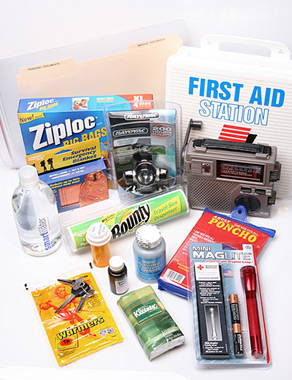 Here's what she suggests. Sorry for the length.
Here's what she suggests. Sorry for the length.Assembling a First Aid Kit
_Activated charcoal (use only if instructed by poison control center)
_Adhesive tape
_Antiseptic ointment
_Band-Aids (assorted sizes)
_Blanket
_Cold pack
_Disposable gloves
_Gauze pads and roller gauze (assorted sizes)
_Hand cleaner
_Plastic bags
_Scissors and tweezers
_Small flashlight and extra batteries
_Syrup of ipecac (use only if instructed by poison control center) Note: Ipecac is a medicine that can be purchased in any pharmacy without a prescription that, when given to a child or an adult, will induce vomiting.
_Triangular bandage
First Aid Kit Tips
_Whether you buy a first-aid kit or put one together, make sure it has all the items you may need.
_Include any personal items, such as medications and emergency phone numbers, or other items your physician may suggest.
_Check the kit regularly to be sure the flashlight batteries work. Check expiration dates and replace any used or out-of-date items.
_Remember, the contents of a first-aid kit can be dangerous in the hands of young children, so it should be stored out of their reach.
Assembling a Go Bag
According to the New York City Office of Emergency Management, every household should assemble a "go bag"—a collection of items each person might need in the event of an evacuation. A go bag should contain:
_Copies of your important documents in a waterproof and portable container (insurance cards, photo ids, proof of address, and other such items).
_Extra set of car keys and house keys.
_Credit and ATM cards and cash, especially in small denominations (have $50 to $100 on hand).
_Bottled water and nonperishable food such as energy or granola bars.
_Flashlight, battery-operated AM/FM radio and extra batteries. You can also buy a wind-up radio that does not require batteries.
_Medication and other essential personal items. Be sure to refill medications before they expire. Keep a list of the medications each member of your household takes, why they take them, and their dosages.
_A complete first-aid kit.
_Sturdy, comfortable shoes, lightweight raingear, and a Mylar blanket.
_Contact and meeting-place information for your household, and a small regional map.
_Child care supplies or other special care items.
Go Bag Tips
_Each household member's go bag should be packed in a sturdy, easy-to-carry container such as a backpack or suitcase on wheels.
_A go bag should be easily accessible if you have to leave your home in a hurry.
_Make sure it is ready to go at all times of the year.


2 comments:
We need one of these really bad. My friend Rachel is way into it and has Go bags and everything. Including a hatchet!
I want to make go bags for us before the end of the year. We bought a lot of stuff at an outlet here but it's not put together nicely the way Martha recommends.
Post a Comment